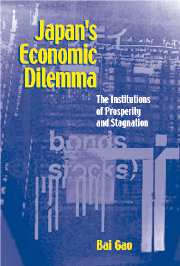Book contents
- Frontmatter
- Contents
- Acknowledgments
- 1 Introduction
- 2 Three Theoretical Issues
- 3 The Rise of the Principles of Coordination and Stability
- 4 Coordination, Excessive Competition, and High-Speed Economic Growth
- 5 Stability, Total Employment, and the Welfare Society
- 6 The Roads to the Bubble
- 7 The Struggle of the Welfare Society
- 8 Fighting the Stagnation
- References
- Index
3 - The Rise of the Principles of Coordination and Stability
Published online by Cambridge University Press: 07 January 2010
- Frontmatter
- Contents
- Acknowledgments
- 1 Introduction
- 2 Three Theoretical Issues
- 3 The Rise of the Principles of Coordination and Stability
- 4 Coordination, Excessive Competition, and High-Speed Economic Growth
- 5 Stability, Total Employment, and the Welfare Society
- 6 The Roads to the Bubble
- 7 The Struggle of the Welfare Society
- 8 Fighting the Stagnation
- References
- Index
Summary
Why does a study of the reversion of the Japanese economy in the 1990s have to start in the 1930s? The reason is that from the perspective of the long-term movement of capitalist economies discussed by either Giovanni Arrighi (1994) or Karl Polanyi (1957 [1944]), the postwar expansion of trade and production and the efforts to support social protection in the 1950s and 1960s must be considered as part of a larger process in this movement. In the previous wave of globalization, the collapse of the gold standard in 1914 triggered a series of crises for capitalist economies on a global scale; in response to the Great Depression and World War II, coordination and stability emerged as the two leading principles of the Japanese economic system, which have significantly influenced the postwar institutional evolution of the Japanese economy. The two structural shifts that took place after the early 1970s and the discussion of the so-called third way (discussed later in this chapter) in the ongoing debate on globalization have reopened two questions: whether the long-term movement of capitalist economies actually occurred as a cycle and what the contemporary implications are of the industrialized countries' responses to the crisis that followed the previous wave of globalization.
In this chapter, I briefly discuss how the collapse of the gold standard and Japan's maladaptation to the new environment led to a series of crises, both domestic and international, and how coordination and stability became the leading principles in the Japanese economy during these crises. During the Great Depression and World War II, strengthening coordination and maintaining stability became the top priorities of the Japanese economic system.
- Type
- Chapter
- Information
- Japan's Economic DilemmaThe Institutional Origins of Prosperity and Stagnation, pp. 48 - 67Publisher: Cambridge University PressPrint publication year: 2001



